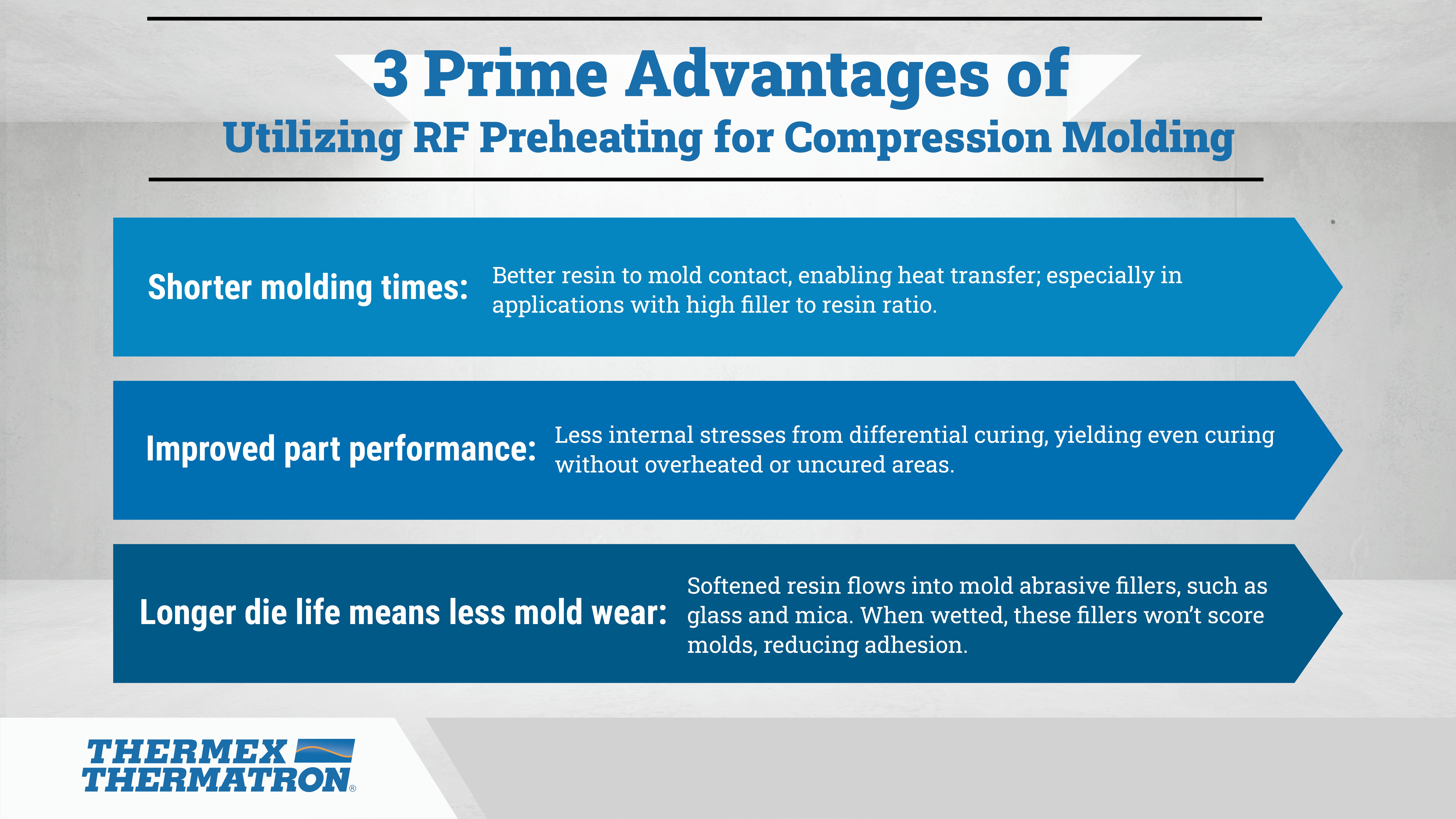RF Preheating 101: The Basics and Advantages of Radio Frequency Preheating of Thermoset Plastics
Thermex-Thermatron Systems
Thermex-Thermatron Systems (“Thermex”) has over eight decades of experience in helping advance the Industrial Radio Frequency (RF) and Microwave (MW) fields, building leading RF Welding and Heat Sealing Equipment, Industrial Microwave Systems, and Industrial Press Systems.
Thermex-Thermatron has been a long-time leader in the RF Preheating arena. Creating a better engineered product comes down to using efficient RF Preheater Systems; something that when leveraged well elevates both quality and throughput on the production floor.
Preparing to tackle the unique characteristics involved with RF heating, innovative technology assists in attaining precise, even, quick, and measured results. As such, it’s beneficial to RF preheat thermoset plastics to start unlocking superior material performance and ramping up your production momentum.

HOW TO MAKE THE MOST OUT OF RF PREHEATING WITH YOUR THERMOSET PLASTICS
Not every polymer resin is a thermoset plastic; only polymer resins that irreversibly cure through a chemical reaction. The cure may be initiated in two ways: 1) solely by chemical means (for instance, two-part epoxy), or 2) achieved through heat (usually above 200 °C or 392 °F). If you use a heat activated resin system, it’s likely that you’re in a solid position to begin RF heating.
After all, most of these systems are ideally suited.
Consider the following five examples as common thermoset plastics that are fit for powerful RF preheating applications:
- Polyester resin — This thermoset plastic is used in sheet molding compound (SMC) as well as in bulk molding compound (BMC). Panels fabricated from polyester resins are then reinforced with fiberglass (FRP). SMC is frequently used in automotive and aircraft components.
- Epoxy — It takes two different types of chemicals to form this copolymer. You can find epoxy-based materials applied in various coatings, adhesives, and composite materials; especially those using fiberglass reinforcement. This includes circuit boards in addition to extruded or pultruded rods and shapes.
- Phenol-formaldehyde (Bakelite) — The world’s first commercially successful synthetic resin, this thermoset plastic comes into play for small, precision-shaped components. Wherever specific properties are required, manufacturers find Bakelite to be an asset for components including molded disc brake pistons, heat resistant handles, electrical plugs, switches, circuit boards, and semiconductor encapsulation.
- Melamine-formaldehyde (Melamine) — Kitchen utensils and plates (such as Melmac) leverage Melamine. Additionally, high-pressure laminates, such as Formica, Arborite, and laminate flooring use this thermoset plastic.
- Urea-formaldehyde (UF) — Helpful as adhesives, UF is used for the bonding of plywood, particleboard, and other structured or engineered wood products.

HOW TO LAND THE RIGHT TIMING: UNDERSTANDING TRADITIONAL THERMOSET COMPRESSION MOLDING
In order to manufacture strong, temperature-resistant thermoset plastics, traditional thermoset molding operations utilize compression molding. It’s crucial to ensure quality, volume, and durability for production.
Navigating this process, manufacturers introduce a measured amount of molding compound (resin, filler, and pigment) into a two part cavity mold, then heat to processing temperature. Under high pressure, the mold is compressed. Slowly, the mold starts closing. As the molding compound gradually melts, it forces its way into the crevices of the mold.
After a period of minutes, heat from the mold migrates through the molding compound until the entire part has reached processing temperature. All parts of the product need to reach at least minimum temperature for the minimum amount of time. When you’ve ascertained this, open the press to remove the finished part(s).
TOP 7 ADVANTAGES OF RF PREHEATING
Materials like melamine or urea compounds contain low heat transfer properties in addition to elevated moisture absorption. Often processed through compression molding, without preheating, molding time runs longer and tooling wear surges, causing product quality to deteriorate and rejects to build up. Preheating mold lessens the contrast in temperature, leading to three major benefits on the production floor:
Compression Molding
- Shorter molding times: Preheated resin provides better resin to mold contact, empowering heat transfer; especially in applications with high filler to resin ratio.
- Improved part performance: This helps to cut down on internal stresses from differential curing; yielding even curing with no overheated or uncured areas.
- Longer die life means less mold wear: Softened resin flows easily into mold-abrasive fillers, such as glass and mica. These fillers are wetted and won’t score molds, facilitating effective bond formation and adhesion.

STRENGTHEN COMPRESSION MOLDING WITH RF PREHEATING
During this process, introduce a measured amount of molding compound into the Thermex-Thermatron RF Preheater. The RF then becomes activated as the molding compound heats to its softening point, usually transpiring quickly — in less than one minute. Then, you can transfer the softened compound to the molding press, immediately closing it. The soft material is free to flow now into the recesses of the mold.
Because the material can hit molding temperature more quickly, reduction in cycle time drives the ability to produce impeccable products for the masses. RF preheating of thermoset plastics is a proven, instrumental technology; one that offers a wide range of competitive edges, including profit rewards and upgraded product quality — all at a viable cost. Maximize the benefits of RF preheating, and you can up level production with cutting-edge speed, power, and accuracy.
About Thermex-Thermatron
Thermex-Thermatron Systems is the premier developer, builder, and manufacturer of high-power industrial systems for heating dielectric materials for radio frequency (RF), microwave (MW), and thermal applications. Drawing on over 80 years of strategic industry insights, Thermex-Thermatron is an expert in commercializing new applications and enhancing critical processes that make production safer around the world.
Visit our new website — Thermex-Thermatron.com — to learn more about a variety of the essential systems and services we offer.
For Thermex and Thermatron inquiries, contact our Director of Sales, Dean Mancuso (Sales@thermex-thermatron.com; 502/916-8972 or 502/243-5636).
For FIAB and Oteman inquiries, contact our Director of Business Development, Traci Evling (Traci@thermex-thermatron.com; 502/916-8981 or 904/662-2169).

